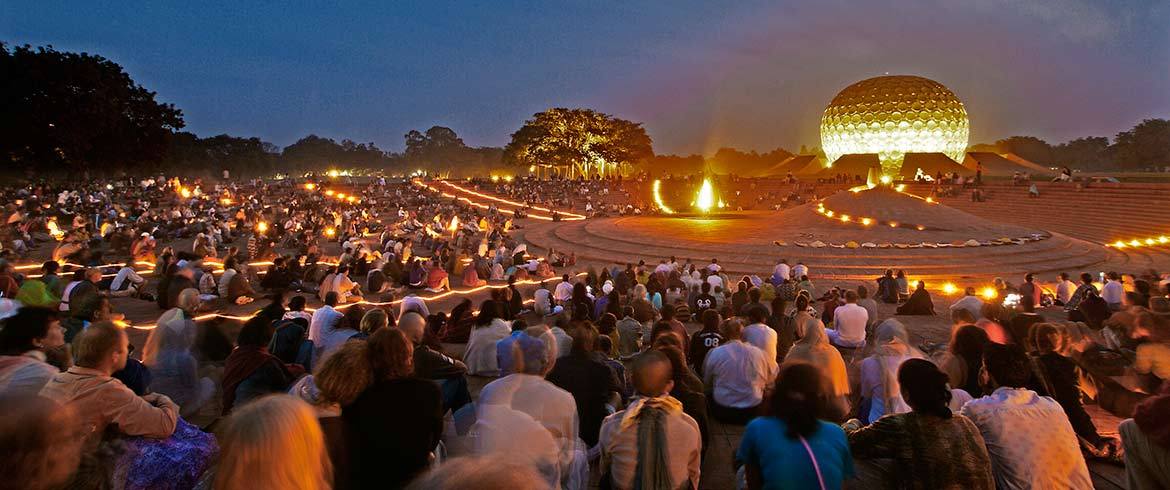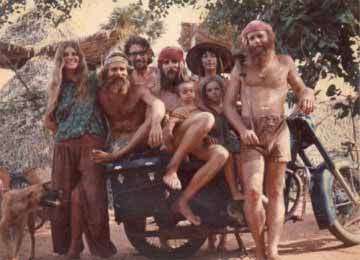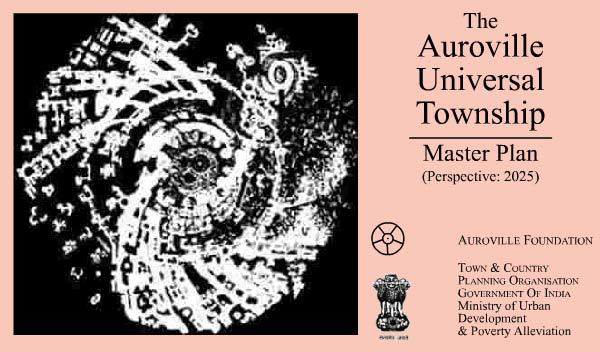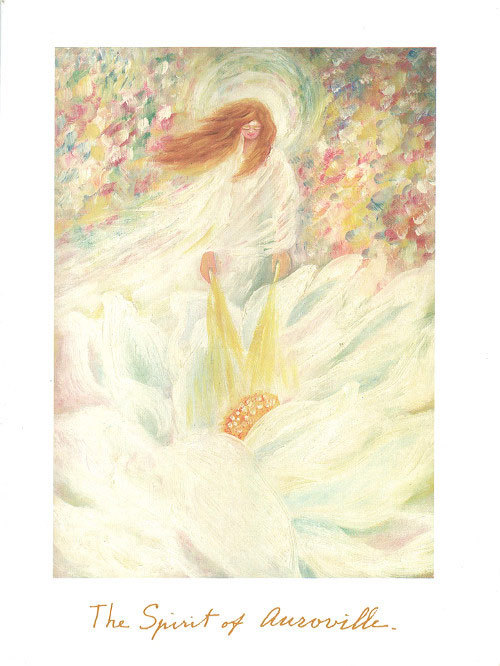Last updated:
The Origins of Auroville
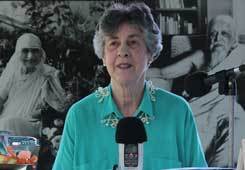
Auroville started her journey on 28th February 1968.
Today she is 43.
'Even if you don't believe it, even if all the circumstances seem quite unfavourable, I KNOW THAT AUROVILLE WILL BE. It may take a hundred years, it may take a thousand years, but Auroville will be because it is DECREED.'
(The Mother's Agenda 21.9.1966)
In fact the Mother always spoke about Auroville as a place already existing, awaiting its time. She called it 'city the earth needs' and it is true that from earliest times the imagination of mankind has been haunted by the fabled names of lost cities or continents below the sea, places of spiritual power and material wealth. Myth and legend bear witness to this need of the human psyche for a place of transformation, for a sacred space where, as Joseph Campbell wrote: at any time the temporal walls may dissolve to reveal a wonder.
How far back must we go to find the true origins of Auroville? How long did this 'dream' lie dormant in the consciousness of the Mother? It was certainly there long before the foundation of the city in 1968. It was there before the first ever mention of the name; before the Mother reported her 'dream' to Surenranath Jauhar on the staircase leading to her room in the Ashram; even before her arrival in Pondicherry and her first meeting with Sri Aurobindo.
In the past there may have been attempts to manifest the ideal -how many we do not know. In conversation the Mother often referred to the 'cosmic tradition', a body of occult teachings transmitted by Max Theon, This enigmatic personage had revived a Society called the Hermetic Brotherhood of Luxor, some of whose members attempted to found a spiritual community in America. The attempt was a failure. Nevertheless historians of the movement have made the connection with Auroville, even referring to it as 'that other step-child of Theon's - Auroville - founded by Mira Alfassa in 1968 to crown the success of the Pondicherry Ashram.'*
There are indications that the origins of Auroville, as a concept of the Mother, can be traced back to a remote past. On several occasions the Mother herself spoke of earlier incarnations in ancient Egypt. It is not surprising then that comparisons have been made between Auroville and the 'city of the horizon' built by the Amenhotep IV (Akenaton) in Upper Egypt around 1369-75 BC. This city was remarkable in its conception and had a profound effect upon human consciousness in its place and time. The old gods of Egypt and their elaborate rituals were abolished in favour of a form of worship of the sun's disk seen as the symbol of life-giving energies that, unlike the old gods, were never represented in any human or animal shape. Like Auroville, Ahkenaton's new city was dedicated to the service of Eternal Truth (Ma' at).
Its long-buried remains came to light only in 1887, when a peasant woman accidentally stumbled upon 300 cuneiform tablets. (Coincidentally, this was the year of the unsuccessful attempt made by the Brotherhood of Luxor to found a spiritually orientated community in America.) Many people have been struck by the similarity between the Auroville Charter and an inscription discovered at Ahkenaton's city:
“Here is the place that belongs to no prince, to no god. Nobody owns it.
This is everybody's place. The earth will find joy in it. Hearts will be happy in it.”
More than three thousand years later, on February 7, 1968, The Mother defined the Charter of Auroville in strikingly similar terms when she wrote:
“Auroville belongs to nobody in particular. Auroville belongs to humanity as a whole. Auroville wants to be the bridge between the past and the future..'
In his book 'The Mother' Georges Van Vrekhem quotes the words of a French teacher at the Ashram school; 'In reply to this question (concerning Akhenaten) I had put to her, Mother let it clearly be understood that she had been Queen Tiy, the mother of Akhenaton... she specified that Akhenaton's revolution was intended to reveal to the people of that time the unity of the Divine and his manifestation. This attempt, the Mother added, was premature, for the human mind was not yet ready for it. It had, however, to be undertaken in order to ensure the continuity of its existence on the mental plane.'
If, as it seems, the idea of Auroville was latent in the Mother's consciousness even before her arrival in Pondicherry, it could not be realised concretely until two crucial events had taken place. The first was her meeting with Sri Aurobindo in March 1914, and the second the 'supramental descent' of February, 1956, which her collaboration with Sri Aurobindo had made possible. Sri Aurobindo had told her: 'With the advent of the supramental force on earth, EVERYWHERE there will be a response'. At last, in 1956, the day came when the Mother could announce to the world: ' A new light breaks upon the earth.' A few years later she would issue her first public statement on Auroville: 'Auroville wants to be a universal town where men and women of all countries are able to live in peace and progressive harmony above all creeds, all politics and all nationalities. The purpose of Auroville is to realise human unity.'
The symbol chosen to represent Auroville was a circle divided into five segments. To some the five divisions represent personalities of the Universal Mahashakti described by Sri Aurobindo, including her personality of Ananda, which has never yet manifested on earth. Others have seen in it the five petals of the Plumeria flower, named by the Mother 'psychological perfection'. Many mysteries are contained in this ancient symbol, for we may also see that, within the circle, the lines take the shape of a five-pointed star around an inner ring with a dot in the centre. In ancient Egypt this hieroglyph was used to denote invisible energies of the spiritual realm. Each line radiating from the centre is like a line of force projecting the main thrust of the Auroville experiment towards its five-fold goal: that is, the discovery of the soul; the evolution of a new consciousness; the realisation of an actual human unity; peace on earth and the end of war; unending progress towards transformation and the 'life divine'. The five segments can be seen as representing an essential unity connecting each of these goals with the others at every point.
From the first, the plan of the new city - the galaxy design - reflected its cosmic significance. At the centre, the Matrimandir would rise like sun in the city of dawn, signifying the beginning of a new age. 'Matrimandir wants to be the symbol of the Divine's answer to man's aspiration for perfection' the Mother wrote. She also said that Matrimandir represented the Divine Consciousness, and that it would be Auroville's soul.
Numerous references in the Agenda suggest that the vision of Auroville did not come all of a piece, but was revealed to the Mother over a period of time. Surendra Nath Jauhar describes a meeting with the Mother on the staircase, when she told him about 'a wonderful dream'. The dream was written down and became the document we all know - 'There should be somewhere on earth a place that no nation could claim as its sole property; a place where all human beings of goodwill, sincere in their aspiration, could live freely as citizens of the world, obeying one single authority, that of the Supreme Truth' this is perhaps the first direct reference to the future Auroville, but the time for the realisation of the dream had not yet come. A still earlier document, dating from 1953, contains the Mother's vision of a future 'international zone'. It forms part of a detailed proposal for a new International University Centre, in which the Mother's words are directly quoted:
'..the cultures of the different regions of the earth will be represented here in such a way as to be accessible to all, not merely intellectually in ideas, theories, principles and languages, but also vitally in habits and customs, in art under all forms….and physically too through natural scenery, dress, games, sports industries and food. A kind of world exhibition has to be organised in which all the countries will be represented in a concrete and living manner - the ideal is that every nation with a very definite culture would have a pavilion representing that culture, built on a model that most displays the habits of that country; it will exhibit the nation's most representative products, natural as well as manufactured, products that best express its intellectual and artistic genius and its spiritual tendencies'
The Mother always made it very clear that her ideal of unity had nothing to do with a featureless uniformity. Her ideal was a harmony and balance in which all the great achievements and aspirations of diverse cultural traditions would find their destined place within the whole. The participation of the entire world in the new venture was especially important to her. From the beginning, this universality was symbolised by the inauguration ceremony on 28th February 1968, when young people from 121 nations and 23 Indian states placed a handful of earth from these countries in a lotus-shaped urn. Soil from the Sri Aurobindo Ashram was carried by Nolini, emphasising the indissoluble bond between these two foundations presided over by the Mother.
The Agenda provides us with a fascinating insight into the Mother's vision of Auroville as it developed over time and reveals how closely it was linked with events in the world outside India. It should be remembered that at the time of Auroville's foundation, the 'Cold War' between Russia and the United States was at its height, and the threat of a nuclear catastrophe seemed ever present. On 21 September, 1966, the Mother voiced her concern about the world situation and the future role of Auroville. She spoke of her ' clear vision that Auroville was a centre of force and creation with, one could say, a grain of truth, and if it could expand and develop, the very movement of its growth would be a reaction against the catastrophic consequences of the arms race. It is interesting that there was no premeditation behind the birth of Auroville; it was simply, as it is always, a Force that acts, a kind of absolute that manifests, and it was so powerful...I obeyed an order, without thinking about it....' At that moment she saw clearly that the creation of Auroville would have an effect on the whole world, and what effect. It would be, she said, 'an action in the invisible'.
The mother's conception of Auroville was characterised by an inspired simplicity that often seemed at variance with the ideas of Auroville's pioneers, many of whom had brought with them all the political and cultural baggage of the world they had left behind. The creation of the Auroville charter, as related in the Agenda on 7.2.68, is a wonderful example of her practical insight into the needs of the moment, seen in the light of an eternal Truth. She takes a black felt- tip pen and spells out in large letters the four points of the charter; encompassing the aims and purpose of Auroville in words so exact and comprehensive, that nothing needs to be added and nothing can be taken away.
- Auroville belongs to nobody in particular. Auroville belongs to humanity as a whole. But to live in Auroville one must be a willing servitor of the Divine Consciousness.
- Auroville will be the place of an unending education, of constant progress and a youth that never ages.
- Auroville wants to be the bridge between the past and the future. Taking advantage of all discoveries from without and from within, Auroville will boldly spring towards future realisations.
- Auroville will be a site of material and spiritual researches for a living embodiment of an actual human unity.
When it was done, she said: 'It is not I who wrote that.I noticed something so interesting: it comes as an imperative, there's no discussion; I write it down, I HAVE TO write, whatever I do. And then, when it's gone it's gone! Even if I try to remember, it's gone! So it is clear that it does not come from here: it comes from above..'
Auroville is much more than the experiment in community living which the casual visitor sees. It is much more than the sum of its achievements up to the present. Its true origins are in the future as well as in the past, for it exists eternally in the Consciousness that embraces time and space. To this eternal dimension, to this vast potential for a transforming action 'in the invisible' we have as yet no access; we have not found the way. Sometimes we catch a glimpse when a little effort appears to produce results out of all proportion, just as Sri Aurobindo said that it would 'in the hour of God'. We see a small group of young people from opposing nations plant trees for peace in Auroville and the Berlin wall comes down and the prospect of war retreats into the background of human affairs. We are reluctant to believe there could be any connection - surely life is more complicated than that? But what if the 'complications' are a veil of falsehood, a fake 'reality' to which we all, somehow, consent? What if a new light breaking upon the world is using us to build a new consciousness?
Auroville is a way of getting things done, a new way that has never been available before. So what does it mean to be an Aurovilian? What is it that the Mother saw so clearly in her vision and wanted people to discover for themselves? She gave so much freedom to those who chose to build this new city - she did not ask them to be philosophers or yogis or saints, or even to have read Sri Aurobindo. She did not require any special skills or talents. She did not impose any rules of conduct or obligatory creeds. The Truth that Auroville serves is ever in movement and cannot be bound by regulations, it leads us on to endless adventures of self-discovery - how beautiful it is to live this Truth that is ageless!
The guidance given by the Mother to those who wanted to be Aurovilians emphasised first of all the need for the inner discovery. 'At the centre there is a being, free and vast and knowing, who awaits our discovery and who should become the active centre of our being and our life in Auroville.' All other guidance given by the Mother centres itself about one crucial point: 'the fulfilment of one's desires bars the way to the inner discovery which can only be achieved in the peace and transparency of perfect disinterestedness.' The conquest of desire - 'to unite with the Divine one must have conquered in oneself the very possibility of desire' is the key that opens the door to all the possibilities of the future. For ordinary human beings, it is perhaps the hardest task, for all are convinced of the validity of their desires.
In the absence of desires something happens: the possibility of contact with a Consciousness that is not limited or masked by our personal preferences. That consciousness is all-knowing and infinitely creative. The Mother brought it down to our human level and it is her legacy to Auroville.
Auroville is a mystery, and will remain so while our human mentality continues to prefer its endless debates, its preferred plans, its personal ambitions, to a simple action conceived in the mind's silence and carried out with perfect sincerity in a spirit of goodwill. As the Mother never tired of reminding us: 'La vraie chose et tellement simple' - reality is so simple.
Sonia Dyne
*The Hermetic Brotherhood of Luxor (1995) Godwin, Chanel & Deveney
